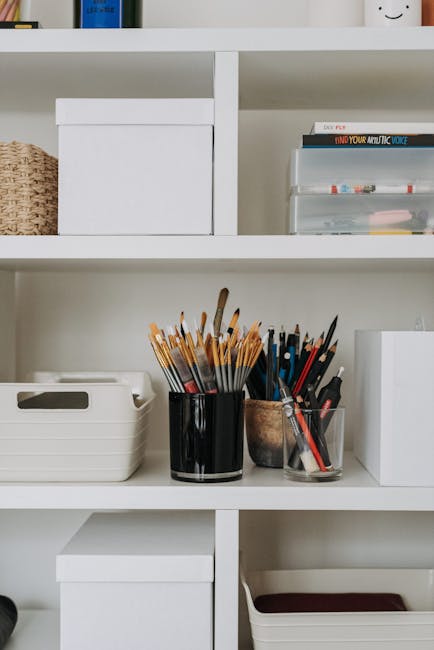
Garage Goals: Organizing Your Space for Functionality
Deconstructing the Chaos: Assessing Your Garage’s Current State
Before diving into bins and shelving units, a critical assessment is paramount. Start by emptying the entire garage, if feasible. This stark exposure reveals the true extent of the disarray and provides a clean slate. Categorize everything into four piles: keep, donate/sell, trash, and relocate (items that belong in the house). Be ruthlessly honest. If you haven’t used an item in a year, it’s likely not worth keeping. This initial purge reduces clutter and simplifies the organization process.
Next, analyze the garage’s existing layout and structural elements. Note the dimensions, window and door placement, ceiling height, and any pre-existing shelving or workbenches. Consider the garage’s primary function. Is it primarily for vehicle storage, a workshop, a storage hub, or a combination? Understanding the intended use will guide the design of your organized space. Pay attention to potential problem areas: damp spots, uneven flooring, or poorly lit corners. Addressing these issues before organizing prevents future damage and ensures a more comfortable and functional space.
Planning Your Organized Garage: Functionality First
Effective garage organization hinges on a well-defined plan. Begin by visualizing the ideal garage layout. Where will vehicles park? Where will tools be stored? Where will recreational equipment be housed? Sketching a simple floor plan can be incredibly helpful. Divide the garage into zones based on function: a parking zone, a workbench zone, a storage zone, and a gardening zone, for example.
Consider vertical space. Walls offer valuable storage potential that is often underutilized. Shelving, pegboards, and wall-mounted cabinets maximize storage without encroaching on floor space. Think about the frequency of use for different items. Frequently used tools should be easily accessible, while seasonal items can be stored higher up or in less accessible areas.
Incorporate safety considerations into your plan. Keep flammable materials in approved containers and away from heat sources. Ensure adequate ventilation, especially in a workshop area. Install proper lighting to improve visibility and safety. Plan for clear pathways to avoid tripping hazards and allow for easy movement around the garage.
Maximizing Vertical Space: Shelving, Pegboards, and Wall-Mounted Solutions
Vertical storage is the cornerstone of garage organization. Shelving units, available in various materials like metal, plastic, and wood, provide versatile storage for a wide range of items. Choose shelves that can handle the weight of the items you plan to store. Adjustable shelves offer flexibility to accommodate different sized items. Consider wire shelving for storing items that need ventilation, such as sports equipment.
Pegboards are ideal for organizing tools and small hardware. Their perforated surface allows for customization with hooks, clips, and baskets. Group tools by type and arrange them in a logical order for easy retrieval. Label each tool location to encourage proper replacement.
Wall-mounted cabinets offer enclosed storage for items you want to keep out of sight or protect from dust and dirt. They’re perfect for storing chemicals, cleaning supplies, or valuable tools. Choose cabinets with durable construction and secure locking mechanisms. Consider installing overhead storage racks for long-term storage of bulky items like holiday decorations or seasonal tires.
Conquering the Clutter: Smart Storage Solutions
Beyond shelves and cabinets, specialized storage solutions can further optimize your garage. Plastic storage bins, available in various sizes and shapes, are perfect for storing items like seasonal clothing, holiday decorations, or sporting goods. Choose clear bins for easy identification of contents. Label each bin clearly to avoid rummaging through multiple containers.
Rolling carts provide mobile storage for tools and equipment. They’re particularly useful in a workshop setting, allowing you to move your tools to the work area. Choose a cart with sturdy wheels and multiple drawers or shelves.
Bike racks are essential for storing bicycles safely and efficiently. Wall-mounted bike racks save valuable floor space. Consider a pulley system to lift bikes overhead for long-term storage.
Optimize your workbench with drawers, cabinets, and pegboards to keep tools organized and within reach. Use a magnetic strip to hold frequently used metal tools. Install a power strip for convenient access to electricity.
Taming the Tangled Web: Cord and Hose Management
Cords and hoses are notorious for creating a tangled mess in the garage. Implement a cord management system to keep them organized and prevent tripping hazards. Use cord winders or Velcro straps to bundle cords together. Hang cords on hooks or racks to keep them off the floor.
Invest in a hose reel to neatly store garden hoses. Wall-mounted hose reels save space and prevent kinks in the hose. Consider using a hose hanger for shorter lengths of hose.
Use bungee cords or rope to tie up long items like lumber or pipes. Hang these items from the ceiling or wall to keep them out of the way.
Maintaining Order: Habits for a Consistently Organized Garage
Organizing your garage is an ongoing process, not a one-time event. Establish habits to maintain order and prevent clutter from accumulating. Regularly purge unwanted items. Schedule a yearly garage cleanout to remove unused items and reorganize your space.
Put items back in their designated place after each use. This simple habit prevents clutter from building up and makes it easier to find things later. Sweep or vacuum the garage floor regularly to remove dirt and debris.
Label everything clearly. Labeling shelves, bins, and tool locations ensures that everyone in the family knows where items belong.
Involve the whole family in the organization process. Assign tasks to each family member to make the process more manageable.
Safety First: Prioritizing a Safe and Functional Garage Environment
Safety should always be a top priority in your garage. Store flammable materials in approved containers and away from heat sources. Install a carbon monoxide detector to alert you to dangerous levels of carbon monoxide.
Keep chemicals and cleaning supplies out of reach of children and pets. Store sharp tools and equipment safely to prevent injuries.
Ensure adequate ventilation, especially in a workshop area. Install proper lighting to improve visibility and safety.
Inspect your garage door regularly to ensure it is functioning properly. Lubricate moving parts to prevent wear and tear.
Install a first aid kit in an easily accessible location. Make sure everyone in the family knows where it is located and how to use it.
By following these tips, you can transform your garage into a functional and organized space that meets your specific needs. A well-organized garage not only improves the appearance of your home but also enhances its functionality and safety. Invest the time and effort to create a garage that you can be proud of.

